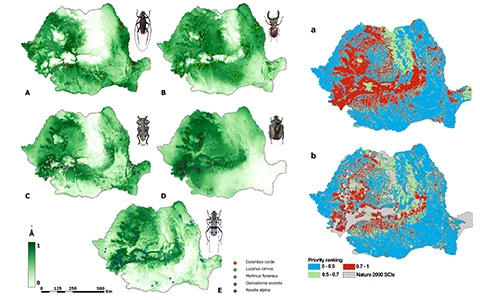The first radiotelemetry monitoring of insects in Romania has begun
In order to document the movement and selection of the habitats of the saproxylic insects Rosalia alpina and Osmoderma eremita, in the Putna Vrancea Natural Park we started the mounting of VHF radio transmitters. For this activity, 0.15 gram radio transmitters (VHF) were selected and purchased, which do not affect the behavior of these species.

Radio telemetry is a method used to study the behavior and movement of animals, in the present case it is used to determine the dispersion and home-range of saproxylic insects. The method involves capturing individuals and attaching a radio transmitter to the insect’s pronotum with a strong, quick-setting adhesive.
Attaching the transmitter is done as quickly as possible and without disturbing or injuring the insect, which is then released in the area where it was captured. In order not to disturb insect dispersal and to have minimal impact on upward flights, the weight of the transmitter should be between 2.3% -3.3% of the insect’s body mass. The transmitter used for monitoring has a weight of 0.5 g, a length of 11 mm and a width of 3.4 mm. Battery life may vary depending on the frequency at which it transmits the radio signal (between 11 and 22 days). The active radio transmitter attached to the insect’s pronotum will emit a radio signal with regular pulses at a fixed radio frequency, being received by the antenna. This, together with the receiver, will be handled by a researcher in the field, who will orient the antenna to determine the direction of the strongest signal, thus making it possible to detect the insect in the field.

Homing type tracking is used when an exact location of the individual is required. The coordinates of each individual with a transmitter attached will be recorded using a GPS and an individual tracking sheet for each transmitter.
Coordinated by the Vrancea Environmental Protection Agency, the Life Rosalia project „Conservation of saproxylic insects in the Carpathians” aims to improve the habitat conditions for five species of saproxylic insects – species of beetles that live in wood that is in the stage of rotting or in the process of rotting – from the forests of the Putna-Vrancea Natural Park.
The project has a duration of implementation of five years, between 2020-2025 and is implemented in partnership with the University of Bucharest, through the Center for Environmental Research and Impact Studies, the National Forest Authority – Putna Vrancea Natural Park and the Association for the Conservation of Biological Diversity ACDB.






